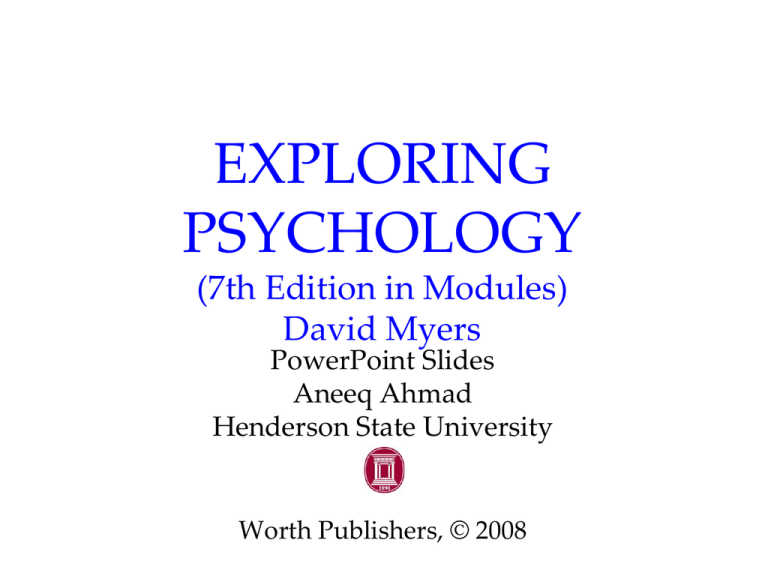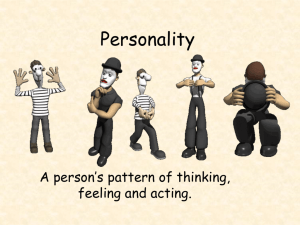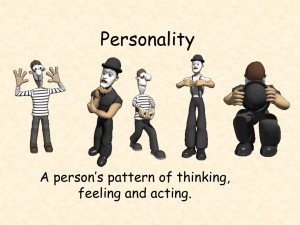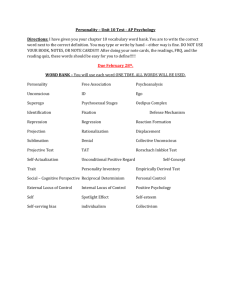
EXPLORING
PSYCHOLOGY
(7th Edition in Modules)
David Myers
PowerPoint Slides
Aneeq Ahmad
Henderson State University
Worth Publishers, © 2008
The Psychoanalytic
Perspective
Module 33
Personality
The Psychoanalytic Perspective
Exploring the Unconscious
The Neo-Freudian and
Psychodynamic Theories
Assessing Unconscious Processes
Evaluating the Psychoanalytic
Perspective
Personality
An individual’s characteristic pattern of
thinking, feeling, and acting.
Each dwarf has a distinct personality.
Psychoanalytic Perspective
Culver Pictures
In his clinical practice,
Freud encountered
patients suffering from
nervous disorders.
Their complaints
could not be explained
in terms of purely
physical causes.
Sigmund Freud
(1856-1939)
Psychodynamic Perspective
Culver Pictures
Freud’s clinical
experience led him to
develop the first
comprehensive theory
of personality, which
included the
unconscious mind,
psychosexual stages,
and defense
mechanisms.
Sigmund Freud
(1856-1939)
Exploring the Unconscious
A reservoir (unconscious mind) of mostly
unacceptable thoughts, wishes, feelings, and
memories. Freud asked patients to say whatever
came to their minds (free association) in order to
tap the unconscious.
http://www.english.upenn.edu
Dream Analysis
Another method to analyze the unconscious
mind is through interpreting manifest and
latent contents of dreams.
The Nightmare, Henry Fuseli (1791)
Psychoanalysis
The process of free
association (chain of
thoughts) leads to
painful, embarrassing
unconscious memories.
Once these memories
are retrieved and
released (treatment:
psychoanalysis) the
patient feels better.
Model of Mind
The mind is like an iceberg. It is mostly hidden,
and below the surface lies the unconscious
mind. The preconscious stores temporary
memories.
Personality Structure
Personality develops as a result of our efforts to
resolve conflicts between our biological impulses
(id) and social restraints (superego).
Id, Ego and Superego
The Id unconsciously strives to satisfy basic
sexual and aggressive drives, operating on the
pleasure principle, demanding immediate
gratification.
The ego functions as the “executive” and
mediates the demands of the id and superego.
The superego provides standards for judgment
(the conscience) and for future aspirations.
Personality Development
Freud believed that personality formed during
the first few years of life divided into
psychosexual stages. During these stages the
id’s pleasure-seeking energies focus on pleasure
sensitive body areas called erogenous zones.
Psychosexual Stages
Freud divided the development of personality
into five psychosexual stages.
Oedipus Complex
A boy’s sexual desire for his mother and
feelings of jealousy and hatred for the rival
father. A girl’s desire for her father is called the
Electra complex.
Identification
From the K. Vandervelde private collection
Children cope with
threatening feelings by
repressing them and
by identifying with the
rival parent. Through
this process of
identification, their
superego gains
strength that
incorporates their
parents’ values.
Defense Mechanisms
The ego’s protective methods of reducing
anxiety by unconsciously distorting reality.
1. Repression banishes anxiety-arousing
thoughts, feelings, and memories from
consciousness.
2. Regression leads an individual faced with
anxiety to retreat to a more infantile
psychosexual stage.
Defense Mechanisms
3. Reaction Formation causes the ego to
unconsciously switch unacceptable
impulses into their opposites. People may
express feelings of purity when they may be
suffering anxiety from unconscious feelings
about sex.
4. Projection leads people to disguise their
own threatening impulses by attributing
them to others.
Defense Mechanisms
5. Rationalization offers self-justifying
explanations in place of the real, more
threatening, unconscious reasons for one’s
actions.
6. Displacement shifts sexual or aggressive
impulses toward a more acceptable or less
threatening object or person, redirecting
anger toward a safer outlet.
The Neo-Freudians
National Library of Medicine
Like Freud, Adler
believed in childhood
tensions. However, these
tensions were social in
nature and not sexual. A
child struggles with an
inferiority complex
during growth and
strives for superiority
and power.
Alfred Adler (1870-1937)
The Neo-Freudians
The Bettmann Archive/ Corbis
Like Adler, Horney
believed in the social
aspects of childhood
growth and
development. She
countered Freud’s
assumption that
women have weak
superegos and suffer
from “penis envy.”
Karen Horney (1885-1952)
The Neo-Freudians
Archive of the History of American Psychology/ University of Akron
Jung believed in the
collective unconscious,
which contained a
common reservoir of
images derived from our
species’ past. This is why
many cultures share
certain myths and images
such as the mother being
a symbol of nurturance.
Carl Jung (1875-1961)
Assessing Unconscious Processes
Evaluating personality from an unconscious
mind’s perspective would require a
psychological instrument (projective tests) that
would reveal the hidden unconscious mind.
Thematic Apperception Test
(TAT)
Developed by Henry Murray, the TAT is a
projective test in which people express their inner
feelings and interests through the stories they make
up about ambiguous scenes.
Lew Merrim/ Photo Researcher, Inc.
Rorschach Inkblot Test
The most widely used projective test uses a set
of 10 inkblots and was designed by Hermann
Rorschach. It seeks to identify people’s inner
feelings by analyzing their interpretations of the
blots.
Lew Merrim/ Photo Researcher, Inc.
Projective Tests: Criticisms
Critics argue that projective tests lack both
reliability (consistency of results) and validity
(predicting what it is supposed to).
1. When evaluating the same patient, even
trained raters come up with different
interpretations (reliability).
2. Projective tests may misdiagnose a normal
individual as pathological (validity).
Evaluating the Psychoanalytic
Perspective
Modern Research
1. Personality develops throughout life and is
not fixed in childhood.
2. Freud underemphasized peer influence on
the individual, which may be as powerful
as parental influence.
3. Gender identity may develop before 5-6
years of age.
Evaluating the Psychoanalytic
Perspective
Modern Research
4. There may be other reasons for dreams
besides wish fulfillment.
5. Verbal slips can be explained on the basis of
cognitive processing of verbal choices.
6. Suppressed sexuality leads to psychological
disorders. Sexual inhibition has decreased,
but psychological disorders have not.
Evaluating the Psychoanalytic
Perspective
Freud's psychoanalytic theory rests on the
repression of painful experiences into the
unconscious mind.
The majority of children, death camp survivors,
and battle-scarred veterans are unable to
repress painful experiences into their
unconscious mind.
The Modern Unconscious Mind
Modern research shows the existence of nonconscious information processing. This involves:
1.
schemas that automatically control perceptions and
interpretations
2.
the right-hemisphere activity that enables the splitbrain patient’s left hand to carry out an instruction the
patient cannot verbalize
3.
parallel processing during vision and thinking
4.
implicit memories
5.
emotions that activate instantly without consciousness
6.
self-concept and stereotypes that unconsciously
influence us
Evaluating the Psychoanalytic
Perspective
The scientific merits of Freud’s theory have
been criticized. Psychoanalysis is meagerly
testable. Most of its concepts arise out of clinical
practice, which are the after-the-fact
explanation.








